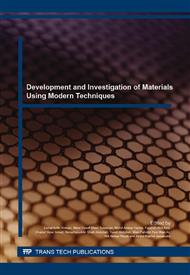[1]
A. Masingu, G. Piccaluga, G. Pinna: Structural Properties of Lead-Iron Phosphate Glasses by X-Ray Diffraction J. Non-Cryst. Solids. 122 (1990) 52-56.
DOI: 10.1016/0022-3093(90)90224-a
Google Scholar
[2]
R. l. Prabhakar, Jc. Knowles: Effect of glass composition on the degradation properties and ion release characteristics of phosphate glass—polycaprolactone composites Biomater. 26 (2005) 2209-2218.
DOI: 10.1016/j.biomaterials.2004.07.016
Google Scholar
[3]
C.F. Drake, W. M, Allen: Biochem. Soc. Trans. 13 (1985) 516-520.
Google Scholar
[4]
R.I. Ahmed, D. Ready, M. Wilson, J.C. Knowles: Structure and properties of strontium-doped phosphate-based glasses Biomed. Mater. Res. 78 (2006) 618-625.
Google Scholar
[5]
P. Christian, C.A. Scothford: Long-term craniofacial osteoblast culture on a sodium phosphate and a calcium/sodium phosphate glass. Biomed. Mater. Res. 66 (2003) 233-240.
DOI: 10.1002/jbm.a.10574
Google Scholar
[6]
Bitar, V. Salleh, V. Mudera, J.C. Knowles, M. Lewis: Soluble phosphate glasses: in vitro studies using human cells of hard and soft tissue origin. Biomater. 25 (2004) 2283-2292.
DOI: 10.1016/j.biomaterials.2003.08.054
Google Scholar
[7]
I. Ahmed, M. Lewis, I. Olsen, J.C. Knowles: Processing, characterization and biocompatibility of iron-phosphate glass fibers for tissue engineering. Biomaterials. 25 (2004) 3223-3232.
DOI: 10.1016/j.biomaterials.2003.10.013
Google Scholar
[8]
C. S Ray, X. Fang, M. Karabulut, G.K. Marasinghe, De, Day: Effect of melting temperature and time on iron valence and crystallization of iron phosphate glasses. J. Non-Crystal. Solid. 1 (1999) 1-16.
DOI: 10.1016/s0022-3093(99)00304-x
Google Scholar
[9]
E.A. Abou Neel, I. Ahmed, J. Pratten, S. N, Nazhat: Characterisation of antibacterial copper releasing degradable phosphate glass fibres. Biomater. 26 (2005) 2247-2254.
DOI: 10.1016/j.biomaterials.2004.07.024
Google Scholar
[10]
R. Shah, Acm. Sinanan. Np. Hunt, Mp. Lewis: Craniofacial muscle engineering using a 3-dimensional phosphate glass fibre construct. Biomater. 26 (2005) 1497-1505.
DOI: 10.1016/j.biomaterials.2004.04.049
Google Scholar
[11]
M. Navarro, J.A. Planell: Cellular response to calcium phosphate glasses with controlled solubili J. Biomed. Mater. Res. 67 (2003) 1009-1015.
DOI: 10.1002/jbm.a.20014
Google Scholar
[12]
M. Karabulut, G.K. Marasinghe, C.S. Ray, D.E. Day, G.D. Waddill, C.H. Booth, P.G. Allen, J.J. Bucher, D.L. Caulder, D.K. Shuh: Iron phosphate glasses: Structure determination and displacement energy thresholds, using a fixed charge potential model. J. Non-Cryst. Solids. 306 (2002).
DOI: 10.1016/s0022-3093(02)01053-0
Google Scholar
[13]
K. Joseph, K.V. Govindan: Studies on the synthesis and characterization of cesium-containing iron phosphate glasses. J. Nucl. Mater. 384 (2009) 262–267.
DOI: 10.1016/j.jnucmat.2008.11.016
Google Scholar
[14]
E.A. Abou Neel, I. Ahmed, J.J. Blaker , A. Bismarck , A.R. Boccaccini , M.P. Lewis, S.N. Nazhat, J.C. Knowles: Effect of iron on the surface, degradation and ion release properties of phosphate-based glass fibres. Act. Biomater. 1 (2005) 553-563.
DOI: 10.1016/j.actbio.2005.05.001
Google Scholar
[15]
P.Y. Shih, Mater. Chem. Phys. Properties and FTIR spectra of lead phosphate glasses for nuclear waste immobilization. 80 (2003) 299–304.
DOI: 10.1016/s0254-0584(02)00516-3
Google Scholar
[16]
P. Pascuta, G. Borodi, A. Popa, V. Dan, E. Culea, Influence of iron ions on the structural and magnetic properties of some zinc-phosphate glasses. Mater. Chem. Phys. 123 (2010) 767- 777.
DOI: 10.1016/j.matchemphys.2010.05.056
Google Scholar
[17]
D.A. Magdas, O. Cozar, V. Chis, I. Ardelean, N. Vedeanu, Influence of MoO 3 on the Structure of Lithium Aluminum Phosphate Glasses. Vib. Spectrosc. 48 (2008) 251–254.
DOI: 10.1016/j.vibspec.2008.02.016
Google Scholar
[18]
B.V. Raghavaiah, C. Laxmikanth, N. Veeraiah, Optically induced effects in nano-crystallized PbO–Sb2O3–B2O3: Pr2O3 glasses. Opt. Commun. 235 (2004) 341–345.
DOI: 10.1016/j.jallcom.2010.03.221
Google Scholar


